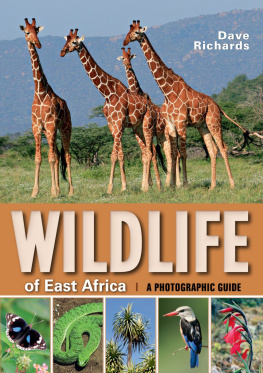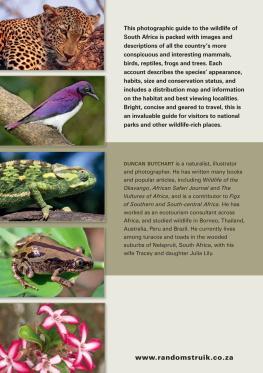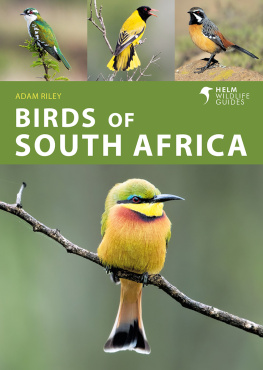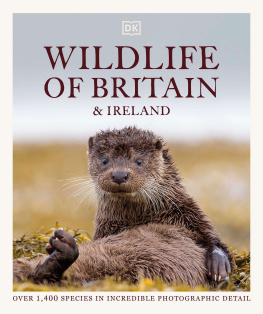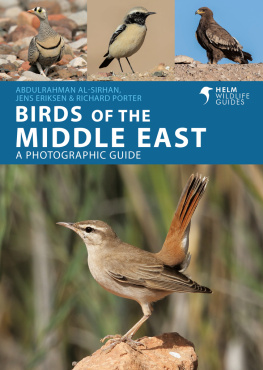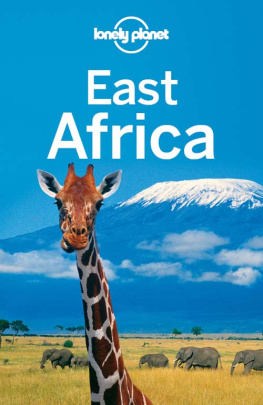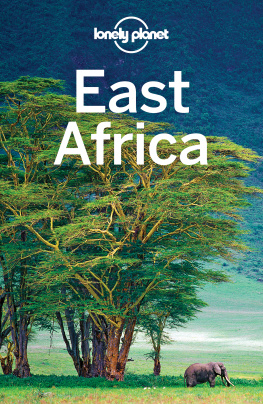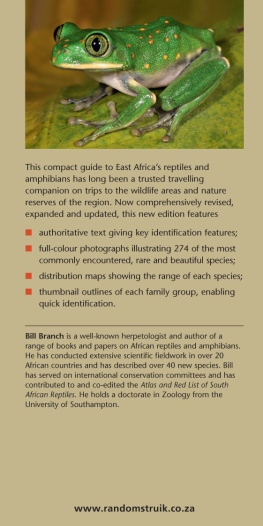Dave Richards - Wildlife of East Africa: A Photographic Guide
Here you can read online Dave Richards - Wildlife of East Africa: A Photographic Guide full text of the book (entire story) in english for free. Download pdf and epub, get meaning, cover and reviews about this ebook. year: 2011, publisher: Struik Nature, genre: Home and family. Description of the work, (preface) as well as reviews are available. Best literature library LitArk.com created for fans of good reading and offers a wide selection of genres:
Romance novel
Science fiction
Adventure
Detective
Science
History
Home and family
Prose
Art
Politics
Computer
Non-fiction
Religion
Business
Children
Humor
Choose a favorite category and find really read worthwhile books. Enjoy immersion in the world of imagination, feel the emotions of the characters or learn something new for yourself, make an fascinating discovery.
- Book:Wildlife of East Africa: A Photographic Guide
- Author:
- Publisher:Struik Nature
- Genre:
- Year:2011
- Rating:4 / 5
- Favourites:Add to favourites
- Your mark:
- 80
- 1
- 2
- 3
- 4
- 5
Wildlife of East Africa: A Photographic Guide: summary, description and annotation
We offer to read an annotation, description, summary or preface (depends on what the author of the book "Wildlife of East Africa: A Photographic Guide" wrote himself). If you haven't found the necessary information about the book — write in the comments, we will try to find it.
Wildlife of East Africa: A Photographic Guide — read online for free the complete book (whole text) full work
Below is the text of the book, divided by pages. System saving the place of the last page read, allows you to conveniently read the book "Wildlife of East Africa: A Photographic Guide" online for free, without having to search again every time where you left off. Put a bookmark, and you can go to the page where you finished reading at any time.
Font size:
Interval:
Bookmark:


Published by Struik Nature
(an imprint of Random House Struik (Pty) Ltd)
Reg. No. 1966/003153/07
First Floor, Wembley Square,
Solan Road, Gardens, Cape Town, 8001
PO Box 1144, Cape Town, 8000 South Africa
Visit www.randomstruik.co.za and join the Struik Nature
Club for updates, news, events, and special offers
First published in 2013
This ebook edition in 2013
Copyright in text, 2013: Dave Richards
Copyright in photographs, 2013: Dave Richards,
except where otherwise indicated
Copyright in maps, 2013: Random House Struik (Pty) Ltd
Copyright in published edition, 2013: Random House Struik (Pty) Ltd
Publisher: Pippa Parker
Managing editor: Helen de Villiers
Editor: Lesley Hay-Whitton
Project manager: Colette Alves
Design director: Janice Evans
Layout: Neil Bester
Proofreader: Emsie du Plessis
All rights reserved. No part of this publication may be reproduced, stored in a retrieval system, or transmitted, in any form or by any means, electronic, mechanical, photocopying, recording or otherwise, without the prior written permission of the copyright owner(s).
ISBN 978 1 77007 891 8 (Print)
ISBN 978 1 77584 077 0 (ePDF)
ISBN 978 1 77584 078 7 (ePUB)
: Zanzibar Red Colobus Paolo Torchio; Woodland Kingfisher Dave Richards; Galam White-lipped Frog Alan Channing; Migratory Butterfly, Red-leaved Rock Fig, Desert Rose Dave Richards
First of all, I have to thank my wife, Val, for her help, patience and support throughout the many months while I was writing this guidebook and, especially, when I was away for long periods in the bush.
The following people (not in any particular order) have given me help and advice in various ways, and I apologise to anyone I have inadvertently left out.
Dr Geoffrey Mwachala, Dr Itambo Malombe, the late Tim Noad, Gordon Boy, Karen Maclean, Harrison Kinyanku Nampaso, Patrick Reynolds, Dino Martins, Wilson Lolpapit, Brian Finch, Steve Collins, Paul Oliver, Will Knocker, Bruce Patterson, Paolo Torchio, Sue Allan, Wendy and Alan McKittrick, Amedeo Buonajuti, David Elsworthy, Don Turner, Brian Williams, Patrick Beresford, Lis Farrell, Ben Mgambi, Marcell Claassen, Musa Lekwale and Charles Mwangi Gitau. A special thanks also to all the staff and, particularly, the guides of Governors Camps, for all their help.
Last but not least, I have to thank Pippa Parker of Random House Struik for her tireless support and encouragement and her team in Cape Town, including Colette Alves, Colette Stott and Lesley Hay-Whitton, for all their care taken in helping me to complete this, my latest guidebook.

Lesser Flamingos on Lake Magadi, Kenya
East Africa an area that comprises Kenya, Tanzania, Uganda, Burundi and Rwanda is one of the most wildlife-rich regions in Africa. This region is intersected by several major biomes, with the result that its vegetation is very diverse. It is bisected by two rift valleys, running north to south, which contain numerous lakes, both fresh water and soda. It also has a number of isolated mountains, with their own varied habitats. These include the ice- and snow-covered Kilimanjaro (the highest mountain in Africa), montane forests, tropical rain forests, semi-desert, savanna, mangrove forests and a palm-fringed coastline, with its many lagoons and estuaries. This diversity of vegetation and animal life makes this the premier wildlife viewing region in Africa.
The mountains in the west are home to the rare and endangered Mountain Gorilla, which occurs both in Rwanda and Uganda. Chimpanzees are also found in Rwanda, Uganda and Tanzania. One of the worlds largest migrations of mammals takes place between Tanzania and Kenya, with over one million Wildebeest, accompanied by approximately 200 000 Zebra and thousands of Gazelle, moving to better grazing areas.
The economic benefits that result from the conservation of the regions wildlife have now been realised, and wildlife tourism has become a major source of revenue and employment. There has been a huge upsurge of interest in Africa and its wildlife. Viewing wildlife in natural surroundings is a satisfying experience, and there is arguably no better way to relax from the stresses and strains of modern life. However, most visitors would benefit more if they had information on the wildlife they were watching.
The aim of this compact guidebook is to help visitors to the regions national parks, national reserves and other wildlife areas enjoy the wildlife even more. It does not claim to be a comprehensive field guide, but is an introduction to the more noticeable and interesting mammals, birds, reptiles, frogs, trees, flowers and insects (including butterflies) that can be seen on safari. Comprehensive guides are available for each group, with the exception, perhaps, of butterflies. Anyone who would like more detailed information should consult the list of recommended reading matter in the bibliography on .
This book illustrates and describes a carefully selected range of species, with notes on their identification, habitat, status, size and, if applicable, the best locations in which to see them. Chapters are arranged in such a way that similar or related species are placed together for comparison, but this means that the sequence more typical of comprehensive reference books has not always been followed.
The East African topography is a study of contrasts. Features range from snow-capped mountains and deserts, sandy coastlines and fresh-water lakes, to savanna grasslands, fertile agricultural plantations, extinct volcanoes and coral reefs.
The surface relief of East Africa is more varied than most other parts of the continent.
Areas below 500 m are confined to the coast and parts of interior eastern Tanzania, eastern Kenya and the Lake Turkana area in northern Kenya. Most of the remaining region is plateau country (between 500 and 1 500 m), with highland areas in northern Rwanda, southwestern Uganda, western and central Kenya, and much of interior Tanzania.
The region is bisected by two rift valleys. In the west is the Central African Rift Valley, which runs from the Sudan in the north down to Malawi in the south, and roughly forms the political borders of the DRC with Uganda, Rwanda and Burundi. This valley contains a number of fresh-water lakes, which all vary in altitude above sea level, from Lake Albert (612 m), Lake Edward and Lake George (both 913 m), to Lake Kivu (1 460 m). Lake Tanganyika, the worlds second-deepest lake, with a depth of 1 435 m, is also located in this Rift Valley, 773 m above sea level.
In the east is the better-known East African Rift Valley or The Great Rift Valley, which runs from the Red Sea across Ethiopia, through Kenya and Tanzania. This also has a chain of lakes, some of which are alkaline, and again all at varying altitudes. In northern Kenya is Lake Turkana (375 m), and, to the south, Lake Baringo (972 m), Lake Nakuru (1 753 m), Lake Naivasha (1 890 m) and Lake Magadi (579 m). Across the border in Tanzania are Lake Natron (610 m), Lake Manyara (960 m) and Lake Eyasi (1 030 m). A feature of these eastern Rift Valley lakes is that none have outlets, or at least no obvious ones.
Font size:
Interval:
Bookmark:
Similar books «Wildlife of East Africa: A Photographic Guide»
Look at similar books to Wildlife of East Africa: A Photographic Guide. We have selected literature similar in name and meaning in the hope of providing readers with more options to find new, interesting, not yet read works.
Discussion, reviews of the book Wildlife of East Africa: A Photographic Guide and just readers' own opinions. Leave your comments, write what you think about the work, its meaning or the main characters. Specify what exactly you liked and what you didn't like, and why you think so.

